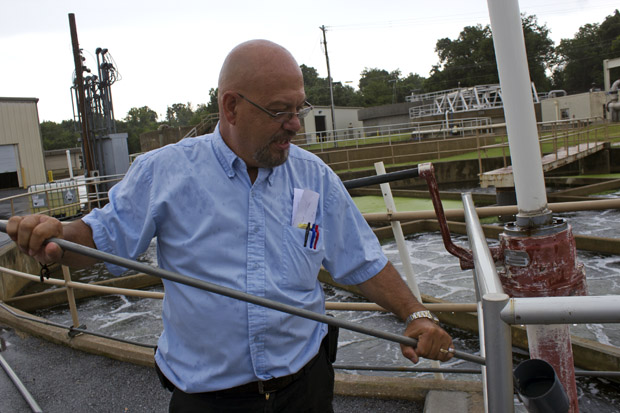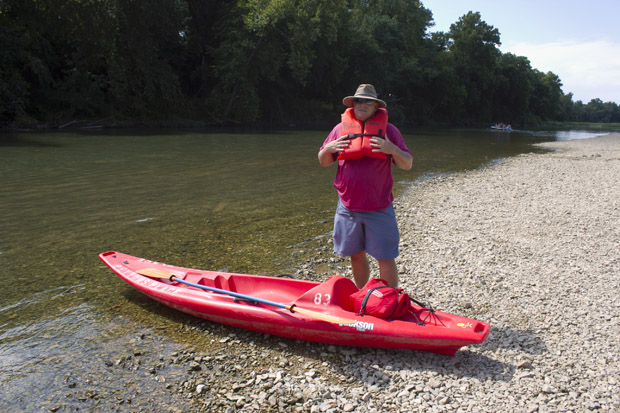
Tom Myers, superintendent of the new wastewater treatment plant in Siloam Springs, Ark., holds a sample of treated water that will be discharged into Oklahoma's Flint Creek.
Joe Wertz / StateImpact Oklahoma


Tom Myers, superintendent of the new wastewater treatment plant in Siloam Springs, Ark., holds a sample of treated water that will be discharged into Oklahoma's Flint Creek.
Joe Wertz / StateImpact Oklahoma

Joe Wertz / StateImpact Oklahoma
Bob Deitrick of Owasso stands along the banks of the Upper Illinois River at the Round Hollow public access point north of Tahlequah, Okla. The headwaters of this river are in Arkansas.
This is part two of StateImpact Oklahoma’s four-part series on the history of Oklahoma’s scenic rivers and the environmental threats they face. Part one is available here.
Bob Deitrick checks the snaps on his bright orange life vest, crouches and checks all the gear one last time. The Owasso father’s son and his two friends are behind him, impatiently paddling in circles.
Even amid a swarm of splashing, screaming boys, Deitrick drifts away when he’s on the water.
“It’s peaceful, relaxing.”
But the present tranquility of the Upper Illinois — and most of the state’s scenic rivers — springs from a turbulent history that was fueled by water pollution in other states.
First it was Ohio, whose Cuyahoga River was oozing with oily sludge, industrial waste and debris. After the river caught fire in 1969, states like Oklahoma started getting serious about water pollution.
The out-of-state influence continued in the 1980s with Arkansas, home of the headwaters for four of Oklahoma’s Scenic Rivers: Flint Creek, Barren Fork, Big Lee Creek and the Illinois River.
Oklahoma blamed Arkansas for polluting rivers with phosphorus from sewage and fertilizer runoff from chicken farms. In 1986, the state of Oklahoma sued the Arkansas city of Fayetteville to prevent it from discharging into the Illinois River. The case made it all the way to the U.S. Supreme Court, which ruled unanimously in 1992 that upstream Arkansas had to follow the water quality standards of downstream Oklahoma.
The two states in 1997 agreed on standards to dramatically reduce the amount of phosphorus flowing into Oklahoma’s Lake Tenkiller. And in 2002, Oklahoma adopted the country’s first numerical water quality standard for phosphorus.

Joe Wertz / StateImpact Oklahoma
Tom Myers, superintendent of the new wastewater treatment plant in Siloam Springs, Ark., holds a sample of treated water that will flow into Oklahoma's Flint Creek.
Compliance with Oklahoma’s water quality rules has been costly for cities and industries in Arkansas that discharge into creeks and streams that flow into the Illinois River watershed. Most of the $24 million the City of Siloam Springs recently spent to upgrade its water treatment plant, for example, was to outfit the facility with the high-tech equipment necessary to meet Oklahoma’s strict phosphorus standards, says facility superintendent Tom Myers.
“We’re only 700 feet from Oklahoma,” he says. Siloam Springs also treats wastewater from local poultry producers Cobb-Vantress and Simmons Foods, and water discharged from a rubber manufacturing plant owned by Gates Corporation. Myers says all three industrial operations have worked with officials to reduce pollutants in wastewater before it reaches the city’s treatment plant.
“We’re seeing an improvement in water clarity and quality in the Illinois River Basin,” Ed Fite, executive director of the Scenic Rivers Commission told StateImpact in January.
Efforts in Arkansas are having a positive effect, but it will likely take years to understand whether they’ll have a lasting positive impact on waterways in Oklahoma, he says.
Meanwhile, other regional Oklahoma/Arkansas water conflicts drag on.
In 2005, Oklahoma Attorney General Drew Edmonson filed a lawsuit against poultry companies over pollution in the Illinois River watershed, but while the trial ended in February 2010, U.S. District Court Judge Gregory Frizzell still hasn’t issued a ruling.
Also ongoing is the two states’ 2013 agreement to a third-party study of water quality in the Illinois River, which isn’t due until 2016. Many environmental groups are optimistic about the two-state study, but some, including Ed Brocksmith of the Tahlequah-based group Save the Illinois River, worry it will result in phosphorus limits that are lower than those currently in place in Oklahoma.
Back at the Rocky Hollow public access point along the Upper Illinois River north of Tahlequah — 60 miles downstream of the Siloam Springs waste treatment plant, Bob Deitrick says he thinks strict water pollution rules are important.
“Obviously for the beauty, keep the stream running clean,” he says. “These are great places that God created for us.”
But Deitrick says protecting scenic rivers isn’t just the responsibility of state government agencies.
Before he pushes off and paddles to catch up with his son, Deitrick bends down and picks up a candy bar wrapper from the gravelly bank. He stuffs it in his pocket before pushing off the gravelly bank and paddling to catch up with his son.
Correction: Story updated on Aug. 21, 2014 to show that Drew Edmondson was Oklahoma’s Attorney General when the 2005 poultry lawsuit was filed, not current AG Scott Pruitt.